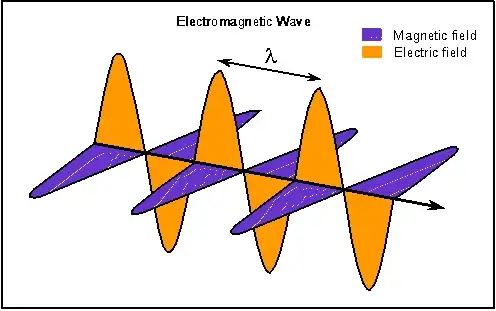Linear antenna directed along z, photons (EM waves) propagate along x. Momentum of photons have only x component. Why electrons in antenna have z component of momentum?
4 Answers
Photons are quanta of electromagnetic waves which are transverse so if the momentum of the photon goes in the $x$-direction, then the magnetic and electric fields are in the transverse $yz$-plane, for example $B$ may be in the $y$ direction and $E$ may be in the $z$ direction. Because the electric field accelerates charged particles in the same (or opposite) direction, electrons will be accelerated in the $z$ direction as well.

If the wave is unpolarized, about 50 percent of its energy will be composed of the wave above and 50 percent will be composed of the other way where the directions of $B,E$ are interchanged. This other wave won't be able to shake the electrons.
- 182,599
Maybe interesting for some to take this a bit further:
This classical behavior goes all the way down to single cycle laser pulses which ionize atoms by accelerating them in the direction transverse to the motion of the laser pulse. Make sure to look at the very interesting (Realplayer) video...
http://www.cfa.harvard.edu/itamp/attosecondpdfs/paulus.pdf
http://cfa-www.harvard.edu/dvlwrap/itamp/0311/paulus.ram
Why is this behavior still classical?
(1) Because in this case even the single cycle of the ultrashort laser pulse has a wavelength much longer as the size of the field of the (bounded) electron.
(2) The single cycle laser pulse kicks the electron in one direction.
When, how and why do we get quantum mechanical Compton scattering effects?
When: Mainly if the wavelength of radiation becomes smaller (e.g. x-ray) as the volume in which the electron is contained.
How: The electron gets kicked in the direction parallel to the momentum of the photon.
Why: The electron can self-interfere when going from an initial state $\psi_i$ to a final state $\psi_f$. The interference current is a sinusoidal pattern of alternating charge and spin density with the same wavelength and direction as the incoming photon. The direction of the electron spin is essential in the interaction because it is the effective current from the alternating spin density which is the source of an alternating transverse electromagnetic field which compensates the electromagnetic field of the incoming photon: The photon is absorbed. Finally, the state of the electron after absorbing the photon isn't that of a free electron and another transition takes place under the emission of an outgoing photon which leaves the electron in a free (on-the-mass-shell) state. The math which describes these processes corresponds to the tree-level Feynman diagrams of the interaction
Regards, Hans
- 4,485
- 24
- 26
The electrons in the antenna are moving perpendicular to the direction of motion of the emitted radiation. This is natural for a transverse wave. Since light is a transverse wave, as shown by Luboš Motl's beautiful graphic, there's nothing surprising here.
- 13,059
There are 2 different effects of the EM waves:
- Acceleration of charges due to EM field
- Radiation pressure of the EM field
If the EM wave propagates along x direction and your antenna is along the z direction, then electrons will be driven along the antenna by the electric field. On the other hand, the antenna will also receive an overall impact (momentum) along the x direction because of the radiation pressure (which does not affect the antenna practically since its effect is tiny and the antenna is fastened).
It is also worth pointing out that there are 2 descriptions of radiation:
- the classical description (EM waves) and
- the quantum description (photons)
The quantum description is more general. Both pictures are identical only in the limit of so many photons. Electromagnetic waves can be described in terms of photons, but individual photons cannot be described in terms of electromagnetic waves. Photons description is more fundamental.
- 17,504